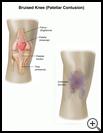
Bruised Kneecap
________________________________________________________________________
KEY POINTS
- A bruise is an injury that causes bleeding under the skin that make it discolored.
- Depending on the injury, your provider may tell you to use crutches until your knee heals. Your healthcare provider may recommend stretching and strengthening exercises to help you heal.
________________________________________________________________________
What is a bruised kneecap?
A bruise is an injury that causes bleeding under the skin that make it discolored. A bruised kneecap is discoloration around your kneecap (patella).
What is the cause?
A bruised kneecap usually happens from falling onto your knee or by being hit on the knee by an object.
What are the symptoms?
Symptoms may include:
- Pain directly over your kneecap
- Swelling in your knee or on the outer side of your knee
How is it diagnosed?
Your healthcare provider will ask about your symptoms, activities, and medical history and examine you. You may have X-rays or other scans.
How is it treated?
While you are recovering from your injury, you may need to change your sport or activity to one that does not make your condition worse. For example, you may need to swim or bicycle instead of run.
Depending on the injury, your provider may tell you to use crutches until your knee heals.
Your healthcare provider may recommend stretching and strengthening exercises to help you heal.
The effects of a bruised kneecap may last several days or longer.
How can I take care of myself?
To help the swelling and pain:
- Put an ice pack, gel pack, or package of frozen vegetables wrapped in a cloth on the injured area every 3 to 4 hours for up to 20 minutes at a time.
- Keep your knee up on a pillow when you sit or lie down.
- Take nonprescription pain medicine, such as acetaminophen, ibuprofen, or naproxen. Read the label and take as directed. Unless recommended by your healthcare provider, you should not take these medicines for more than 10 days.
- Nonsteroidal anti-inflammatory medicines (NSAIDs), such as ibuprofen, naproxen, and aspirin, may cause stomach bleeding and other problems. These risks increase with age.
- Acetaminophen may cause liver damage or other problems. Unless recommended by your provider, don't take more than 3000 milligrams (mg) in 24 hours. To make sure you don’t take too much, check other medicines you take to see if they also contain acetaminophen. Ask your provider if you need to avoid drinking alcohol while taking this medicine.
Follow your healthcare provider's instructions, including doing exercises to help you recover. Ask your provider:
- How and when you will get your test results
- How long it will take to recover
- If there are activities you should avoid and when you can return to your normal activities
- How to take care of yourself at home
- What symptoms or problems you should watch for and what to do if you have them
Make sure you know when you should come back for a checkup. Keep all appointments for provider visits or tests.
How can I help prevent a bruised kneecap?
Most bruised kneecaps are caused by accidents that cannot be prevented. Follow the safety rules for your work or sport and use protective equipment such as knee pads.

